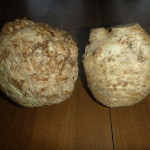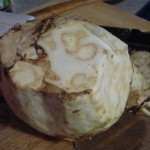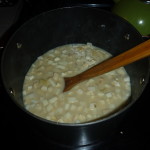Have you ever seen the knobby, bulbous root vegetable celeriac and wondered what you could make with it?
Well, we have a Cream of Celeriac Soup for you this Meatless Monday, as well as celeriac growing, storage and preparation tips from our Vermont Fresh: A Fruit and Vegetable Handbook.
Kim Wittorff, a volunteer testing and tasting recipes out of the Vermont Fresh Handbook worked on this one. Her comments are below the recipe in italics.
Background
Celeriac is closely related to celery, as you will notice as soon as you taste or smell it, but the root is eaten instead of the stems. Although celeriac tops look a lot like celery, the edible root portion closely resembles a gnarled rutabaga or turnip. Like many other vegetables, celeriac is probably native to the Mediterranean region. Widely used in Europe, celeriac is a little-known vegetable in the United States, perhaps in part because it looks so inedible. Don’t be fooled, though—it’s delicious! Celeriac can be substituted for celery in almost any recipe and has the advantage of storing much better.
Growing Tips
For the home gardener, celeriac is an easier alternative to celery. Celeriac has a long growing season, start it indoors in early April. Soak the tiny seeds overnight and sprinkle atop your potting soil, gently pressing them down. Transplant seedlings once temperatures are reliably warm, being sure to harden them off first (in this case, by reducing water, not temperature). If consistently exposed to cold temperatures for too long, celeriac will bolt instead of producing a full root. Though they might be small at first, plant the seedlings about 6 inches apart so the roots have room to swell. Celeriac likes rich, well-watered soil, but requires little attention while growing. Harvest in early fall, before heavy frosts, or earlier for a smaller, slightly more tender root.
Storage
Celeriac can be stored in the refrigerator for a few weeks. Cut off the stems and wrap loosely in plastic, being sure to leave the skin of the root intact (don’t worry too much about getting it perfectly clean). For long-term preservation, celeriac can be frozen. Trim off stems and small roots, then slice off the skin and cube the flesh. Blanch in boiling water for a few minutes, then chill in ice water. Pack into a freezer-safe bag and store in freezer for months. Celeriac can also be root cellared. For longest preservation, store in damp sand at near-freezing.
Preparation
Extremely large roots often have a pithy center, so choose slightly smaller, heavy-feeling roots if possible. Roots should feel firm and, if freshly harvested, they will be slightly green near the top. If you purchase celeriac with the greens attached (or grow it yourself), discard the tops before cooking or storing the vegetable. Celeriac needs to be peeled before eating, but the skin is too aggressive for a vegetable peeler. Slice the skin off in sections with a large knife. Try raw or cooked!
Nutritional Benefits
Eating celeriac is a great way to incorporate fiber, vitamin C, potassium, calcium, and iron into your diet. Compared to many root vegetables, it is low in starch.
Meatless Monday Recipe: Cream of Celeriac Soup
- Photo courtesy of Kim Wittorff
- Photo courtesy of Kim Wittorff
- Photo courtesy of Kim Wittorff
- Photo courtesy of Kim Wittorff
- Photo courtesy of Kim Wittorff
Serves 4-6
(adapted slightly from seasonalchef.com)
Ingredients
- 1 large onion, chopped
- 3 tablespoons butter
- 2 tablespoons flour
- 2 pounds celeriac, peeled and finely diced
- 1 teaspoon coarse salt
- 2 cups milk
- 4 cups vegetable broth
Instructions
- In a heavy-bottomed pot, melt butter over medium heat.
- Cook onions until tender. Sprinkle with flour and stir until flour begins to brown.
- Pour in milk and heat, then add celery, salt, and broth.
- Bring to a boil, then reduce heat and simmer until vegetables are tender.
- Using a blender or immersion blender, puree the contents of the pot, being careful not to burn yourself (be cautious when opening the blender, as hot liquids may “burp” out).
- Return to pot and heat through. Serve hot.
Notes from Kim:
Cost:
- celeriac – $7
- chicken broth – $5
- milk – $0.65
- onion, butter, flour, salt – estimate $0.50
- total cost = $13.15 which is $2.19 per serving
Time: 1 hour
Servings: 5 or 6
I have never used celeriac, so I was excited to try this recipe. My local grocery store did not carry celeriac, and the produce guy didn’t know what I was talking about when I asked. I had to go to City Market in Burlington to find it, and then it was only available as an organic item.
Straightforward to make. Blender was easy to use and it all fit in two batches. The soup has a distinct taste that works better as a side dish than a main course. The broth only has 1 g protein per serving, which isn’t enough to make the soup a meal. I tried it as a main course at first, but the taste was too strong and needs something – perhaps ham if you’re not attached to this as a Meatless Monday meal.
To receive more recipes and tips on your favorite fruits and vegetables, download Vermont Fresh: A Fruit and Vegetable Handbook. We also need more volunteer home chefs for this project.
Vermont Foodbank fresh food initiatives would not be possible without your support. Please consider giving to the Vermont Foodbank today!






